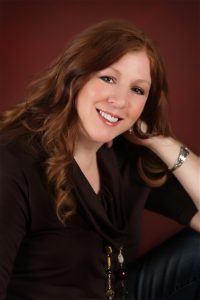We’ve been putting on our conference for 40+ years (only 30 spots left for July’s conference). We believe that part of our recipe for success is that we’re a conference for writers put on by writers. The planning committee is a team of volunteers and we choose to give back because the conference has given so much to us. We’re all on our own writing journeys, alone and together. Committee member Maye Ralston interviewed fellow committee member Janis Thornton about her latest book and her journey. 
Janis Thornton is a freelance writer, personal historian, and award-winning journalist. She is the author of two local history books, Images of America: Tipton County and Images of America: Frankfort. She is a member of Sisters in Crime, the Indiana Writers Center, Association of Personal Historians, and the Midwest Writers Workshop Planning Committee. She lives in a small town in Indiana, not unlike Elmwood—the setting in her debut novel Dust Bunnies and Dead Bodies.
MWW: Being a journalist and having written two nonfiction histories, why did you turn to writing fiction? Is this something you always wanted to do?
JT: Actually, Maye, I was writing fiction long before I landed my newspaper job or wrote two local history books. So, I’ve taken the liberty of flipping your question to … “After writing fiction, why did you turn to journalism?” And the simple answer is the joy of writing for me is the telling of stories, whether the stories are about news events, people’s lives, community histories, or fictional situations generated by my own imagination. Telling a great story, regardless of its origin, in a way that captivates and moves readers emotionally brings me more satisfaction than almost anything I do.
MWW: Where did you get the idea for Dust Bunnies and Dead Bodies? Do you have any plans to write a series using these characters or this setting?
JT: When I first began the project that finally became Dust Bunnies and Dead Bodies, I had only an inkling of a story about a 20-year-old unsolved murder, the three main characters, and the small-town Indiana setting. After I started plotting and cobbling an outline together, I needed a motive for murder that was both gripping and plausible. Around that time, the national news was being dominated by reports of abuse of power by a college football coach … and voila! There it was, the element I had been seeking for the crux of the mystery. Once I had all of that in place, the rest of the story sort of came together organically.
As for a series… yes, I am planning to produce more stories starring the DBDB characters and am noodling around right now with the plot for their next big adventure.
MWW: Are any of your characters inspired by personalities or places you’ve encountered?
JT: Absolutely. I guarantee that if you read the book, the next time you pass through my little hometown of Tipton, you’ll experience some déjà vou. And many of the characters exhibit traits of real people I know. Of course, when I’m asked to reveal the source of inspiration for those traits that happen to be less than admirable, I take the fifth.
MWW: I noticed your main character, Crystal Cropper, is also a journalist. Is she based on you? How is she alike or different from you?
JT: Crystal Cropper is me, and the fabulous person I would like to be. At times, Crystal exemplifies facets of my actual life experience; other times she portrays attitudes, actions, courage, wisdom, and skills that I lack or am too shy to exhibit. Naturally, having been a newspaper reporter, I was able to infuse Crystal with those skills (although hers are FAR better than my own) and perspectives. Besides her career, Crystal parallels my life in many other ways—such as her cooking competency and bowling techniques!
MWW: Did you “pants” this novel, or did you plot it out before you began writing? Which method do you generally prefer?
JT: Some writers feel that making an outline stilts their creativity; while I, on the other hand, find writing an outline a creative process in itself. For me, plotting is a must, particularly for a mystery, where it’s pretty much essential for the writer to know the ending from the very start. Initially, I’ll write an outline using broad strokes, crafting the story’s backbone and markers for where I need to be as the story progresses. Once I get deep into the actual writing (often a process of “write, delete, cry, repeat”), I stay on the lookout for the wonderful surprises that invariably pop up. When that happens, I make the necessary adjustments to the outline and plod on.
And then there’s that funny little mind shift, when the characters become “real” to the writer and attempt a mutiny. At that point, the writer’s challenge is to either keep her characters on the plotted path or follow them at her own peril. So, what I’m trying to say is, an outline works best when the writer considers it a dynamic path rather than a static rut.
MWW: What made you decide to become a writer?
JT: I was 12 when a national anthology featuring poetry by junior high students published the poem I wrote about my dog. After that, I was always writing little stories and poems, but primarily they were for my eyes only. That changed, in the late 1980s, when I signed up for my first fiction-writing class, and wow … a whole new world opened up to me. I began producing longer pieces with purpose as I learned techniques, what worked and what didn’t, all while I was getting feedback. I began to trust that if I could imagine a scene or a story, I could write it. It was an exciting discovery process that has never stopped.
MWW: Do you generally get the idea for your storylines first, or do you create a character first and then get a storyline from that?
JT: I see that as a sort of a “chicken or egg” riddle. Character and story are both essential, of course, and work in a sort of symbiotic way—with the characters driving plot and plot conjuring up characters. Typically, a story comes to me when I imagine a character in a particular situation. Then I start filling in who, what, where, when, why, how come, and so what?
MWW: What kind of books do you enjoy reading? Do you have any favorite authors?
JT: I am a big fan of mysteries and particularly mysteries by William Kent Krueger, Sue Grafton, and Michael Connelly. I also love anything written by Elizabeth Berg, who I discovered about 20 years ago and was thrilled to see at last summer’s MWW.
MWW: Is there anything else you’d like to share?
JT: Yep … I’ve been attending Midwest Writers Workshop events since the late ’90s, and they have been an invaluable resource for information, ideas, instruction, inspiration, and a sense of belonging to a community of writers. I’ll take this opportunity to thank Jama Bigger and her team again for the outstanding job they do organizing the workshops and for outdoing themselves each passing year. And thank you, Maye, for this opportunity to say so.



